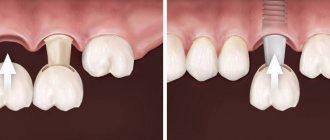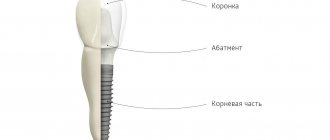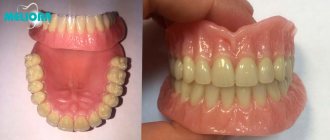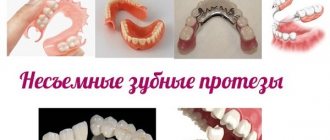Prices at Doctor Zhuravlev Clinic
| Plastic crown (temporary) | PC. | 1000 rub. |
| Solid crown | PC. | 3600 rub. |
| Metal-ceramic crown | PC. | 6000 rub. |
| Metal-ceramic crown on an implant | PC. | 15,000 rub. |
| Zirconium oxide crown for implant | PC. | 16,000 rub. |
| Crown based on zirconium oxide | PC. | 13000 rub. |
| Partial removable denture | PC. | 14,000 rub. |
| Complete removable denture | PC. | 16,000 rub. |
| Nylon prosthesis for 1 jaw | PC. | 30,000 rub. |
| Nylon prosthesis with a metal base for 1 jaw | PC. | 33,000 rub. |
| Clasp prosthesis | PC. | 36,000 rub. |
| Surgery to install an Astra Tech implant (Sweden) (the cost of the implant is paid separately) | PC. | 20,000 rub. |
Many of us have had to lose permanent teeth - completely or partially. When only the visible – crown – part of the tooth is destroyed, dentists do not consider this “unit” lost, because even on the remaining root, restoration can be carried out using a core tab and a crown. But it also happens that a tooth must be removed, and then it will have to be replaced with an artificial one. Is it mandatory to insert teeth if they are not visible and their absence does not spoil the smile? Without restoration of the dentition, degradation processes may begin:
- it becomes more difficult to chew food;
- teeth, due to uneven load, may shift towards the removed root (if the root remains but the upper part of the tooth is missing, then this does not happen);
- the bone tissue of the jaw begins to gradually dissolve in the place where the tooth is missing, as it does not receive adequate load;
- facial features are distorted.
That is why, after extraction, the clinic will always offer you to insert teeth, and which ones are better is up to you and your doctor to decide. You should proceed from your financial capabilities, and the doctor should look at what method of prosthetics is indicated for you.
Types of metal crowns
If you contact a specialist to install a metal crown, you will be offered two options depending on the method of its manufacture:
- Stamped. A standard sleeve, which is processed with a special apparatus to give it the desired shape.
- Solid cast. It is made from individual casts by firing in a kiln. It has thicker walls, which has a positive effect on service life.
They are made from noble (gold, palladium, silver, platinum) and base metals (steel, nickel and chromium alloys). Because of their metallic color, they are used only for prosthetic teeth on the side teeth, which are not visible when speaking. Ideal for prosthetics of chewing teeth, as they can withstand heavy loads.
How to insert teeth: methods used today
Everyone is interested in which teeth are best to insert, what materials are used for this, and how long will you have to wait until the dentures or crowns are ready? More inquisitive patients ask: are wisdom teeth prosthetic? It all depends on the specific case. If, for example, you need to insert three teeth – the 5th, 6th and 7th, then the 8th tooth may well become the supporting one. But if only the wisdom tooth itself is lost, then it does not need to be replaced. If a removable prosthesis of chewing teeth is made, then, as a rule, there are no “eights” in it: this is justified, since the amount of work of the dental technician is reduced and, accordingly, the patient’s costs are reduced. The remaining teeth - canines, incisors, molars - are definitely subject to prosthetics.
There are several ways to insert teeth:
- Make a removable denture based on natural or implanted teeth.
- Replace a missing tooth with an implant.
- Place a bridge supported by an implant or natural teeth.
- Install a clasp prosthesis.
- Create a removable denture supported by soft tissue and mucous membrane with complete edentia.
There are also several materials from which crowns and artificial teeth are made. They vary significantly in cost, which allows you to choose prosthetic options for different budgets.
All modern methods of restoring lost teeth
Just 20 - 30 years ago, metal teeth in the front part of the jaw were not considered something shameful. Moreover, many dreamed of inserting gold teeth, since a golden smile was associated with wealth. Today, dental treatment is technologically advanced, effective and painless, and there are many more ways to insert teeth. Despite the variety of dental services, it is very important for the patient to find good dentistry and a competent specialist who will provide professional assistance. There are hundreds of reviews online where people complain that their teeth were inserted poorly or that the inserted tooth hurts. Unfortunately, such consequences are not uncommon, and their elimination requires repeated treatment and additional costs.
All prosthetic methods are divided into two types: single restoration and complex prosthetics (when you need to replace several lost units or insert complete teeth). Single restoration in most cases is carried out using special inlays (veneers or lumineers) and crowns that are installed on natural teeth or implants. When several teeth are lost or completely edentulous, bridges or removable dentures are used, supported by implants, natural teeth or the oral mucosa. Let's look at these designs in more detail and start with regular dental crowns.
- Metal-ceramic teeth
The crown is based on a metal frame, onto which layers of ceramic are applied under the influence of high temperatures. Such designs are relatively inexpensive and are used for prosthetics of front teeth. Metal tends to oxidize, so over time a bluish outline may form around the gums, which has a bad effect on aesthetics. - Ceramic tooth
These crowns are indistinguishable from natural teeth. Modern ceramics are installed both on the anterior units and on the chewing teeth. The price of ceramic crowns is perhaps their only drawback. The cost of such products is higher than that of similar structures using a metal base. This is why not every patient can afford to have a ceramic tooth inserted. - Zirconium teeth
Today, zirconium dioxide crowns are considered the best of similar designs available on the market. They are as durable as metal crowns, and in aesthetics they are not inferior to ceramic structures. With the help of zirconium crowns, teeth are successfully inserted in any area of the jaw, but when planning to restore lost units, take into account the fairly high cost of such crowns.
Is it expensive to get teeth inserted?
Unfortunately, if you expect to receive the services of an orthopedic dentist under your insurance policy, then you will not be able to do this. Of course, if you belong to preferential categories of citizens, then you can use such medical care for free or receive substantial compensation. In other cases, you can only count on a tax deduction. Therefore, there is no big difference whether you go to a private or public dental clinic. Sometimes even commercial medical institutions hold promotions that will make prosthetics cheaper for you.
Choosing where to get treatment
You can choose a dental clinic based on price level, but you just need to make sure that they can help you there. Sometimes it happens that someone’s teeth were inserted poorly, after which complications arose or the result turned out to be unaesthetic. Typically, such patients leave unflattering reviews about a medical institution or a specific doctor. They also write where they went next, and where they managed to fix everything. However, you should not completely rely on these reviews. After all, if a person writes and does not know what kind of doctor he is who inserts teeth, what his specialty is called, then is it worth trusting such assessments? Anyone who actually underwent treatment knows for sure that he consulted an orthopedist or orthodontist, that the prosthesis was made by a dental technician - and this is a different specialist, and that the preparatory work was done by a dental therapist. In small clinics, a doctor can combine the work of an orthopedist and a therapist, but never also act as a dental technician!
So it’s always better to rely on the choice of your friends rather than on the opinion of a stranger who left a review on the site. Such a person could be hired by competitors to ruin the reputation of the dental clinic.
Types of dental implantation
When choosing cheap implantation, a lot depends on the procedure method. Today it is customary to distinguish the following methods:
Two-stage implantation with delayed loading
She is a classic. This option takes a long period of time - from 3 months to 1-1.5 years. In addition to standard diagnostics, preparation for treatment, and direct installation of implants, the following stages will be included: mandatory bone tissue augmentation in case of insufficient volume, correction of gum level (surgically or using special formers), installation of a temporary prosthesis, and after the final implantation of the implants in the bone – fixation of a permanent crown. This treatment option takes a long time, and due to the need for additional manipulations, it can cost a pretty penny.
One-stage implantation with immediate loading
The method is becoming increasingly popular because it has a number of advantages:
- saving time: new teeth can be purchased over the weekend, the treatment period, as a rule, is no more than 5-7 days,
- no discomfort: the implant is screwed into the bone, so the procedure does not require cutting into the gum and stitching it together, the healing process is less painful and easier,
- instant restoration of aesthetics and functionality.
When restoring a segment or all teeth in a row, one-stage implantation costs an order of magnitude less. This is explained, firstly, by the absence of the need to build up bone tissue, and secondly, by shortened treatment periods, which means the doctor’s work and the number of visits to him are reduced.
How is this implantation done? Firstly, specially designed implant models are used. Secondly, they use deep bone for attachment, as well as the zygomatic bone, which are less susceptible to resorption, which means that extensions are not required. Thirdly, a prosthesis is immediately installed, which not only stabilizes the implants (i.e. connects, unites them), but also transfers the chewing load to the bone, literally “making it work”, which ensures metabolic processes between tissue cells and their rapid regeneration.
For those who still doubt the issue of dental implantation, it will be interesting to know that quite often residents of Europe, America and Korea arrange “dental tours” to Russia, Bulgaria and Turkey, since treatment here is much cheaper. And the quality is not inferior. But it is important to remember that 90% of the success of dental implantation depends not on the brand of implants, not on the equipment of the clinic, but on the professionalism of the doctor who has sufficient experience, including with complex clinical cases.
Studying price lists
After choosing a clinic, you need to understand how much it costs to insert a tooth, what are the prices per “unit” for a particular method. The cheapest option would be a removable plastic prosthesis, the most expensive would be an implant. If you need to insert a tooth using this method, the price may be quite reasonable, but if you need to insert the teeth completely, then it is better to use the “all on 4” method. In this case, only four implants are installed, onto which the entire jaw structure is attached. This not only makes the procedure cheaper, but also reduces time costs.
If you need to replace several teeth, you can use clasp or bridge structures. They are much cheaper than implants, but they will not protect you completely from loss of bone tissue.
Damage to a metal crown
In some cases, a metal crown can cause harm:
- After its installation, galvanic syndrome may develop. This is caused by the use of several alloys to make the orthopedic structure. The combination of differently charged metals leads to the generation of galvanic current. A metallic taste, swelling and burning in the mouth, headaches, sleep disturbances, and malaise appear.
- A stamped crown is not made from individual impressions, so it is not suitable for fully recreating the functions of a living tooth.
- It does not fit tightly to the tooth, forming a gap between the walls into which food debris gets trapped. Therefore, healthy tissue can begin to rot underneath it.
- A one-piece prosthesis has high thermal conductivity. Therefore, if it was installed on a non-pulpless tooth, unpleasant sensations may occur when eating hot food.
What teeth can be inserted to make them look like real ones?
Today, dentists have practically abandoned metal crowns and dentures in the visible part of the dentition. Among the materials from which dental crowns and dentures are made are zirconium dioxide, ceramics, metal ceramics, and plastic. Ceramic and zirconium dentures are most similar to real teeth, but they are expensive. Plus, porcelain (ceramics) does not have the proper strength for a chewing tooth. Typically, those artificial teeth that bear high loads are made of metal ceramics, metal or zirconium dioxide. Metal is used where teeth are not visible in the smile area, and the patient should not be allergic to this material. Zirconium crowns are expensive and therefore not available to everyone. That is why metal ceramics are the most common at the moment. It has one drawback: the necks of the teeth have a metal strip, which can be noticeable, especially if it oxidizes. Overall, this material is durable and aesthetically pleasing. So, if you have a relatively small budget, it’s worth choosing it.
If you have very little money, then which teeth are best to insert so that the prices do not seem exorbitant? In this situation, you can count on temporary plastic prostheses. They can be made either as removable ones, or as full-fledged crowns on stump inlays or a bridge. The service life of plastic is short, but while wearing such prostheses you can save up for a better option. This is especially true when you need to completely insert teeth.
Methods for restoring anterior and chewing teeth
In the absence of teeth, the best way would be implantation, but if you have contraindications to this procedure, there are alternative options - installing a bridge with grinding of adjacent elements or a soft removable denture with clasps.
The same designs are used for chewing teeth: crowns, implants, removable and bridge dentures. The peculiarity of chewing teeth is that they are subject to heavy loads, so especially strong crowns made of zirconium dioxide or metal-ceramics are usually installed in this section.
If you need to insert 1 tooth
To restore one badly damaged tooth, an orthopedist may suggest a crown. If a tooth is missing, a bridge or implantation is required.
If you need to insert a tooth in place of a removed one
After removing a tooth, it is advisable to insert it within 1 – 2 months, since after some time the processes mentioned above begin to occur. If you want to completely restore the functionality, aesthetics, and anatomy of your tooth, dental implants are your best choice.
If you need to insert three teeth
In modern dentistry, to replace three lost teeth (in a row), a bridge prosthesis on implants is usually installed. If there is a limited budget or there are contraindications to implantation, the prosthesis is placed on the ground adjacent teeth.
If you need to completely insert teeth
Teeth restoration in cases of complete edentia is carried out using removable dentures. The best option is considered to be designs supported by implants, which guarantee the patient a good quality of life. In other cases, removable dentures are used with support on the mucous membrane and soft tissues.
How long does it take to insert teeth?
Is it possible to get teeth inserted in one day so that you don’t have the reputation of a gap-toothed person? If you use modern methods of inserting teeth, you can get quick results. However, a lot depends on the condition of your oral cavity. She needs to be prepared for prosthetics. It is this stage that most often takes a lot of time. Before you insert teeth, they need to be made, and this takes time, because the prosthesis is made individually, based on a cast of your jaw.
Inserting temporary teeth in one visit is quite possible. At least you will not remain toothless for the period while your permanent denture is being made. If the task is not to replace the removed “unit”, but only to insert 1 tooth that is badly damaged, then you will have to visit the dental office several times. For example, you will have a ceramic tooth inserted, but before that:
- heal the root;
- the remains of the coronal part will be removed;
- they will take an impression of the stump inlay;
- they will make it;
- will install;
- the impression will be taken again;
- a crown will be made;
- will carry out a fitting;
- They will install a crown or return it to the dental technician for revision.
Here is the answer to the question: how many days does it take to insert teeth? From one day to several weeks, if we are talking about restoring a tooth from which a strong root remains. But how then are teeth inserted if there is no root? If bridge prosthetics is performed, then you can limit yourself to one impression, but it is unlikely that you will be able to insert teeth without turning the supporting “units”. And preparing teeth also takes time. So in this situation, one visit is not enough.
Today, more and more often there are proposals to insert teeth in one day and even put an immediate load on the implant, whereas previously it was believed that this titanium element must still take root in the human bone tissue before an abutment and crown are installed on it. And this sometimes took several months. What may have changed in technology to allow immediate loading of implants is worth exploring in more detail.
How much does it cost to implant one tooth?
The NovaDent dental clinic works with dental implants from the following manufacturers. We provide a lifetime quality guarantee on all implants.
| Implant type | Cost of installing one implant | Price with metal-ceramic crown |
| AnyOne (South Korea) | 15 450 ₽ | 44 000 ₽ 39 250 ₽ |
| OSSTEM (South Korea) | 25 000 ₽ 19 900 ₽ | 49 000 ₽ 42 240 ₽ |
| Alpha Bio (Israel) | 30 400 ₽ | 49 550 ₽ |
| MIS (Israel) | 30 050 ₽ | 51 550 ₽ |
| Astra TECH (Switzerland) | 51 150 ₽ | 70 750 ₽ |
| Ankylos (Germany) | 47 800 ₽ | 67 700 ₽ |
| NOBEL (Sweden) | 55 000 ₽ 33 900 ₽ | 79 000 ₽ 58 150 ₽ |
| Implant type | Price | Price with metal-ceramic crown |
| AnyOne (South Korea) | 15 000 ₽ | 44 000 ₽ 39 250 ₽ |
| OSSTEM (South Korea) | 25 000 ₽ 19 900 ₽ | 49 000 ₽ 42 240 ₽ |
| Alpha Bio (Israel) | 30 400 ₽ | 49 550 ₽ |
| MIS (Israel) | 30 050 ₽ | 51 550 ₽ |
| Astra TECH (Switzerland) | 51 150 ₽ | 70 750 ₽ |
| Ankylos (Germany) | 47 800 ₽ | 67 700 ₽ |
| NOBEL (Sweden) | 55 000 ₽ 33 900 ₽ | 79 000 ₽ 58 150 ₽ |
Look at the price for turnkey implantation, which includes the cost of the following services:
- Diagnostics and consultation with specialists;
- Implantation surgery;
- Installation of the gum former and abutment;
- Taking impressions and making crowns (temporary and permanent);
- Guaranteed replacement of the implant in case of problems.
What does the price depend on?
The cost of dental implantation consists of the following components:
The volume of preparatory work.
Diagnostic measures, anesthesia, sanitation of the oral cavity, treatment of caries, bone grafting, sinus lifting, installation of a temporary crown and gum former are usually paid separately.
Type of implant selected.
Economy and premium class implants are available on the market. Economy class models include products from Israeli companies Alpha-Bio Tec and Medical Implant Technologies Ltd. (MIS), South Korean brands Osstem and Implantium. The premium segment is represented by the trademarks Nobel (Sweden), Astra-Tech (Switzerland) and Ankilos (Germany).
Implant price:
- The cost of an implant for 1 economy class tooth is from 15 to 30 thousand rubles.
- 1 premium class implant – from 43 thousand to 60 thousand rubles per unit.
Crown material.
Depending on the area of prosthetics (chewing tooth or smile area) and the financial capabilities of the client, you can choose different types of prosthetics. Crowns made of ceramics and zirconium dioxide are considered the most durable and aesthetic; a more economical option is implantation of metal ceramics.
Cost of crowns:
- Ceramics - from 27 thousand rubles.
- Zirconium dioxide – from 29 thousand rubles.
- Metal ceramics - from 22 thousand rubles.
Look at the prices for prosthetics at NovaDent dentistry.
Stages and features of implantation of 1 tooth
The duration of the procedure is individual and in each specific case depends on many factors. Thus, it is possible to place an implant on one tooth in 1 day, while in some situations the preparation may take several weeks. The number of visits to the dentist is influenced by the presence of caries, periodontitis and other oral diseases, as well as the volume of dental tissue at the site of implantation. All these factors determine the number of visits to the dentist and, accordingly, the cost of treatment.
Classical implantation of 1 tooth at the NovaDent dental center is carried out according to the following scheme:
- Free consultation.
The patient is examined by several specialists: a therapist, an implantologist and an orthopedist, contraindications are identified and a treatment plan is drawn up, indicating the timing and cost. - Preparation of the oral cavity.
If necessary, caries and other diseases of the oral cavity are treated, and tartar is removed. If the volume of bone tissue at the implantation site is insufficient, the patient is offered bone grafting, and sinus lift surgery in the upper jaw. - Implantation.
At this stage, the implant is implanted into the tooth socket. With one-stage implantation, a titanium implant is screwed into the alveolar process immediately after tooth extraction. In other cases, the pin is installed through an incision in the gum, and in the case of express implantation, it is inserted using a minimally invasive transgingival method (through a puncture in the gum). - Temporary prosthetics.
Immediately after installing the implant, an impression is taken and a gum former is installed. A few days after the operation, a light plastic crown is fixed to the abutment. The patient wears a temporary crown until osseointegration of the implanted rod is completed. - Permanent prosthetics.
After 3-6 months, in the absence of complications and signs of rejection, the artificial tooth is covered with a permanent metal-ceramic or zirconium crown.
Depending on the clinical picture, dental implantation is carried out according to a one-stage or two-stage surgical protocol. One-stage or single-phase implantation involves installing an implant together with the supragingival part (abutment) in one visit to the dentist. With the classical technique, a titanium rod is installed immediately, and after a few months the gum is cut again and an abutment is installed.
Expert of the article you are reading: Kuzmenko Viktor Valerievich Orthopedist, surgeon, leading specialist of the NovaDent network
17 years
Clinical experience
Krasnogorsk
Moscow region, Krasnogorsk, Podmoskovny Boulevard, 5
+7
Free consultation with this specialist
How to insert a dental implant
Indeed, it can take six months for an implant to heal. But if prosthetics are done in the smile area, then the patient is given a temporary orthopedic structure that covers the defect. It turns out that the proposal to insert teeth in one day actually means eliminating an aesthetic problem rather than returning a person to the ability to chew food as before.
To be fair, it is worth noting that the installation of the implant is done in one visit. This operation is performed under local anesthesia, so the question of whether it is painful to insert a dental implant is unnecessary. How long does it take to insert teeth if you need to replace several lost units in a row? It is better to install implants right away, so as not to drag out the prosthetic process for a long time. However, if the patient has already had an implant installed, but then there is a need for prosthetics for another tooth, then each of these units can be treated separately. It all depends on the specific case.
When is it indicated to install crowns on teeth?
The main indications for installing dental crowns are as follows:
- Severe destruction of the dental unit, in which the natural crown of the tooth has collapsed by more than fifty percent;
- In case of single defects in the dentition (when no more than two units in a row are missing in a row);
- Aesthetic restoration to achieve an attractive tooth color and shape.
Less commonly, crown prosthetics act as an alternative to orthodontic treatment in situations where it is necessary to change the position of one tooth in a row.
USEFUL TO KNOW: Teeth that are more than 50% damaged due to caries or for other reasons should be restored with a crown, not a filling. Large fillings installed quickly on pins fall out, and in addition, teeth filled under such circumstances usually come out of the bite, which can lead to its failure and disruption of the correct distribution of the chewing load.
An even worse option is that a tooth with a huge filling simply cannot withstand the pressure that occurs when chewing food and breaks, and if a pin is placed, the root of the tooth unit may also be damaged. Trauma to the tooth root suggests only one outcome - tooth extraction.
Prosthetics with crowns has not only indications for implementation, but also contraindications, which are important to exclude before starting the treatment process. Crowns are not installed:
- With mobility of the dental unit;
- Abnormally low height of the natural coronal part of the tooth, leading to the collapse of the orthopedic crown;
- When there are a significant number of teeth in rows.
It will be necessary to postpone restoration with crowns even if the diagnosis reveals an inflammatory process in the upper part of the root system of the tooth or poor-quality filling of its canals.
Under such circumstances, it will be necessary to take measures to eliminate temporary contraindications to crowns and only after that the restoration procedure itself.
How long does it take to insert teeth after extraction?
Usually the doctor lets the hole heal and only then takes on prosthetics. After all, it is not always possible to insert a tooth in place of a removed one right away. An exception may be new technologies that allow an implant to be installed directly into the hole. But we are talking only about it, and not about the complete structure. Often such operations are performed under general anesthesia. Teeth can be inserted under anesthesia for those patients who are afraid of the dental office, even if there are no other indications other than psychological ones.
Does it hurt to put teeth in?
It is impossible to say that it is possible to insert ceramic teeth so that the patient does not experience discomfort at any stage. Any prosthesis cannot be made perfectly right away, so it must be adjusted. And if a chewing tooth is inserted incorrectly, it can touch soft tissue when a person chews or even talks. Sometimes even a patient can come and start complaining that after he had a tooth inserted, it hurts. On the one hand, this may seem funny, since an artificial structure cannot hurt on its own. On the other hand, this is a reason to pay attention to the condition of soft tissues, because they are the ones that can hurt and become inflamed. If the prosthesis is made on an inlay, that is, with a real tooth root, then there may be options for the development of periostitis and other inflammatory processes. It is enough for the infection to get into the canal at the root, and the body may not be able to cope with it on its own.
Not only a ceramic tooth can be inserted unsuccessfully, but also a plastic or metal-ceramic one. If possible, the doctor should adjust such a prosthesis on the day of installation so that the patient does not experience pain. The most difficult thing is with removable dentures, as they require long-term correction. Initially, the installation of this orthopedic structure does not cause discomfort, but it may appear later, when the patient has already left the office.
Such dentures rub the gums, so they have to be ground down, and it is not always possible to identify all the problem areas the first time, so that a person feels with the removable structure as with his own teeth. But this is a good way to insert teeth on a limited budget.
Stamped crowns
These are prosthetics that are made from factory sockets, which are given the desired shape. They have thin walls, so there is no need to grind off a large amount of tooth tissue. They are installed if there is no destruction of the roots and at least a third of the tooth crown is preserved.
To create them, stainless steel or gold is used.
The ease of manufacture resulted not only in low cost, but also in the short service life of the product. Gold stamped crowns are made from an alloy that is 90% gold. For the chewing surface, gold of a lower standard is used to increase its resistance to mechanical stress.
Manufacturing stages:
- The patient takes impressions of both jaws to model the crown, which must be done over the next 15 minutes until shrinkage of the material begins.
- The boundaries of the prosthesis are marked on the plaster so that it does not turn out to be too narrow or wide.
- Modeling with wax. Wax is applied to the surface of the plaster to give the crown an anatomical shape.
- Based on the cut out model, a metal stamp is made, which is hammered into the sleeve.
- External stamping is carried out using a screw press.
- The die is removed and the edges are trimmed with crown scissors.
During manufacturing, firing is carried out several times to make the metal more dense and unyielding. The prosthesis should not have cracks or irregularities.
Indications for installation of a stamped crown
Stamped crowns are installed:
- For temporary prosthetics of a baby tooth before replacing it with a permanent one.
- As a supporting element when installing a bridge prosthesis.
- When a tooth is damaged by caries or injured so much that it cannot be restored with a filling.
- To protect a healthy tooth if a clasp denture is installed on it.
Where can I get quality teeth inserted?
If you need prosthetics, it is better to choose a clinic where they do it efficiently. If you don’t have someone who can recommend a doctor or medical institution, then you should go to the website of the clinic that interests you. If it describes in detail how, for example, to insert teeth made of zirconium or metal-ceramics, then this is already a plus. If there is information about specialists, photographs of dentists and dental technicians, then this inspires even more confidence, and when there are one or several pages with certificates - both of the organization and of the doctors - this is the best option. If you still doubt that this is a clinic where they can insert high-quality teeth, then you can call and make an appointment with a doctor. This way you will form an impression of the doctor and understand whether you can be treated by him. After all, personal contact between the doctor and the patient also decides a lot.
Crowns on implants
The price of implant crowns will largely depend on the material used to make the crown and abutment. Typically the following options are selected:
- Metal-ceramic crown + titanium abutment. The price of a crown will be 15 thousand rubles per tooth;
- Zirconium crown and zirconium abutment. The price of a crown starts from 25 thousand rubles.
Of course, prices for crowns on implants are higher, but the high cost in this type of prosthetics is due to the more complex process of making crowns.
Calculate the cost of treatment by taking a short test in 20 seconds!
Do not delay your treatment, because in this matter time plays against us.











